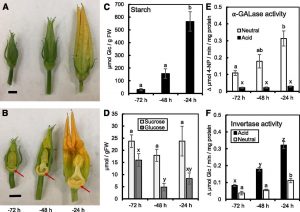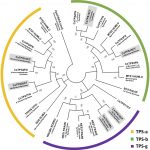Sugar Metabolism in Squash Nectaries and Nectar
Floral nectar is a sugar-rich solution produced by plants to attract animal pollinators. The best-elucidated model of nectar secretion, based on studies of Arabidopsis (Arabidopsis thaliana), involves the build-up and degradation of nectary starch, the resynthesis of Suc from starch-derived hexoses, the export of Suc by the uniporter AtSWEET9, and the extracellular hydrolysis of Suc, which maintains a high intracellular-to-extracellular concentration gradient of Suc while also increasing the solute potential, causing water to flow out into the developing nectar droplet. However, supporting metabolic and biochemical evidence for this model is scarce in other plant species. To fill this gap in our knowledge, Solhaug et al. (10.1104/pp.19.00470) have used squash (Cucurbita pepo) to test whether the model of nectar secretion in Arabidopsis is supported at the metabolic level in other species. Unlike Arabidopsis which produces nectar rich in hexoses, squash produces nectar rich in Suc. Moreover, a typical squash flower makes about a thousand-fold more nectar than a flower of Arabidopsis. In the present study, the authors analyzed the expression and activity of key enzymes involved in carbohydrate metabolism in squash nectaries throughout floral maturation and the associated starch and soluble sugars, as well as nectar volume and sugar under different growth conditions. These efforts revealed that the many of the important steps underlying nectar secretion in Arabidopsis, including nectary starch degradation, Suc synthesis, and Suc export, are supported by metabolic and biochemical data in C. pepo. Additionally, findings presented suggest that sugars imported from the phloem during nectar secretion, without prior storage as starch, are also important for generating C. pepo nectar. Finally, the authors predict that trehalose and trehalose 6-P play important regulatory roles in nectary starch degradation and nectar secretion. These data enhance our understanding of how floral nectar is produced from a metabolic and biochemical perspective.
concentration gradient of Suc while also increasing the solute potential, causing water to flow out into the developing nectar droplet. However, supporting metabolic and biochemical evidence for this model is scarce in other plant species. To fill this gap in our knowledge, Solhaug et al. (10.1104/pp.19.00470) have used squash (Cucurbita pepo) to test whether the model of nectar secretion in Arabidopsis is supported at the metabolic level in other species. Unlike Arabidopsis which produces nectar rich in hexoses, squash produces nectar rich in Suc. Moreover, a typical squash flower makes about a thousand-fold more nectar than a flower of Arabidopsis. In the present study, the authors analyzed the expression and activity of key enzymes involved in carbohydrate metabolism in squash nectaries throughout floral maturation and the associated starch and soluble sugars, as well as nectar volume and sugar under different growth conditions. These efforts revealed that the many of the important steps underlying nectar secretion in Arabidopsis, including nectary starch degradation, Suc synthesis, and Suc export, are supported by metabolic and biochemical data in C. pepo. Additionally, findings presented suggest that sugars imported from the phloem during nectar secretion, without prior storage as starch, are also important for generating C. pepo nectar. Finally, the authors predict that trehalose and trehalose 6-P play important regulatory roles in nectary starch degradation and nectar secretion. These data enhance our understanding of how floral nectar is produced from a metabolic and biochemical perspective.



